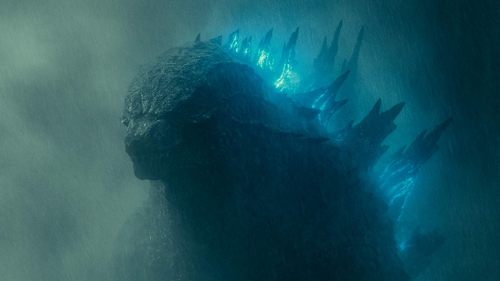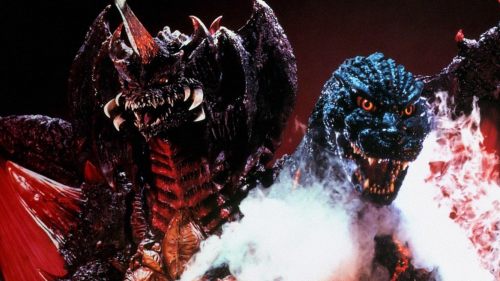Godzilla Week: In Defense Of GODZILLA’S REVENGE
Godzilla: King of the Monsters is here. Get your tickets now!
On Classic Media’s now out-of-print DVD of Godzilla’s Revenge (under its translated original title All Monsters Attack), audio commentator Richard Pusateri says that it’s often cited as either the worst Godzilla movie ever made…or the second worst. He ain’t wrong, and I’ll admit I was in the latter camp (Godzilla vs. Megalon, of course, is the very worst) for quite some time. Via later viewings courtesy of that disc and revival screenings, however, I’ve come to recognize that the film has more to offer than what’s on the surface, and can be appreciated more (and in different ways) by grown-up viewers than by young ones.
It does help if you can watch the movie in its original Japanese with subtitles, since the American Godzilla’s Revenge sports a pretty lousy dub job, particularly when it comes to Minilla/Minya (more on that shortly). A key criticism directed at both editions is the use of stock footage for most of the kaiju scenes, a tactic born of expedience. Although the previous Destroy All Monsters was initially intended to bring the Godzilla series to a spectacular close, Toho decided there was still money to be made from junior audiences and rapidly cranked out All Monsters Attack; it opened in Japan just seven months after Destroy.
Faced with these quickie production circumstances and cost-cutting approach to the bestiary, the franchise’s longtime director Ishiro Honda and screenwriter Shinichi Sekizawa came up with a simple scenario focusing on Ichiro (Tomonori Yazaki), a latchkey kid living in an industrial district. With only one friend, gal pal Sachiko, and often absent parents, he is bullied (more emotionally than physically) by a bigger boy named Gabara, and escapes into dreams/fantasies in which he travels to Monster Island and befriends Minilla, the son of Godzilla, who is able to shrink to Ichiro’s size and speak to him. Minilla has his own Gabara—a towering, ugly humanoid cat creature—to deal with, and as Ichiro witnesses Godzilla’s tough-love encouragement of Minilla to fight his own battles, he develops his own sense of bravery—which he’ll need when he’s kidnapped by a pair of bank robbers after unwittingly picking up a bit of incriminating evidence.
At only 70 minutes—the shortest running time in the series’ history—All Monsters Attack/Godzilla’s Revenge also features the least amount of original creature footage. Not only that, but the bulk of it comes from two movies—Godzilla vs. the Sea Monster and Son of Godzilla—that employed radically different facial designs for the Big G, and even the smallest viewer can’t help but notice his change in appearance from shot to shot. The new material is pretty chintzy; though prominently billed, veteran Toho effects wizard Eiji Tsuburaya (misspelled “Tsburaya” in the American credits) did not actually supervise this work, and it shows. Gabara, with a stiff and plastic-looking face, doesn’t even have a tail to offset its man-in-a-suit origins, and the Minilla costume appears especially phony alongside little human actor Yamazaki. Further lowering the film in the estimation of U.S. viewers, Minilla (who speaks in a child’s tones in the Japanese version, emphasizing his duality with Ichiro) was dubbed in Godzilla’s Revenge with a goofy voice sounding rather like Barney the dinosaur.
Despite all that, it’s the way the monster mashes are used within the narrative that makes this film more interesting and ambitious than many of its Toho stablemates, which only attempt to engage their juvenile audiences in simplistic ways. This is a more personal take on the genre (it may be no accident that its little hero’s name is so close to its director’s) that expresses what the kaiju mean to the children who love them. Kids have long identified with misunderstood monsters, from Frankenstein’s creation to King Kong and beyond, and here, Honda and Sekizawa tap into the empowerment fantasies that their own previous features represented to a generation of young fans. From his dreams of Minilla learning to face up to a much bigger foe, Ichiro finds the courage to not only deal with his own Gabara, but to engage in a cat-and-mouse with the two thieves, whom he incapacitates with booby traps and found objects. (Never mind the recently unearthed French film Dial Code Santa Claus; this is the true genre antecedent to Home Alone.)
For Ichiro, Monster Island is also a place to flee from the complexities and uncertainties of the real world: “We don’t lie. Not like humans,” Minilla tells him early on in the Japanese version. For all the cheapness of the kaiju material, Honda and his team do an evocative job contrasting Ichiro’s harsh everyday environment, with its traffic-clogged streets and pollution-belching smokestacks (prefiguring imagery that would be key to the subsequent Godzilla vs. the Smog Monster), and the lush jungles of Godzilla and Minilla’s realm. And in this context, one can even rationalize the use of the stock footage: Since this movie’s creatures are seen solely in Ichiro’s fantasies, fueled by watching past movies, it’s reasonable that scenes from them are what he dreams of.
Though Ichiro is front and center throughout, the filmmakers find time for small, revealing moments involving his parents and his next-door neighbor Mr. Shinpei (Eisei, a.k.a. Hideyo, Amamoto), a tinkerer and “toy consultant.” In other words, he’s a big kid himself, and the representative of the adult world Ichiro can best relate to. (There’s a quick, telling bit in which the boy channel-flips to a TV soap opera in which “Ichiro” is the romantic adult lead, and recoils in distaste.) For all its perils, Ichiro feels more at home on Monster Island, and that’s the driving theme behind All Monsters Attack/Godzilla’s Revenge. It is, in short, a movie about Godzilla rather than a Godzilla movie, and if that difference means it doesn’t necessarily satisfy on the genre’s usual levels, it was made with enough care in other areas to succeed as a unique take on the form.



